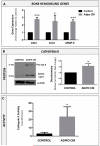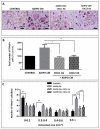Marrow adipocyte-derived CXCL1 and CXCL2 contribute to osteolysis in metastatic prostate cancer
- PMID: 25802102
- PMCID: PMC4393805
- DOI: 10.1007/s10585-015-9714-5
Marrow adipocyte-derived CXCL1 and CXCL2 contribute to osteolysis in metastatic prostate cancer
Abstract
Increased bone marrow adiposity is a common feature of advanced age, obesity and associated metabolic pathologies. Augmented numbers of marrow adipocytes positively correlate with dysregulated bone remodeling, also a well-established complication of metastatic disease. We have shown previously that marrow adiposity accelerates prostate tumor progression in the skeleton and promotes extensive destruction of the bone; however, the factors behind adipocyte-driven osteolysis in the skeletal tumor microenvironment are not currently known. In this study, utilizing in vivo diet-induced models of bone marrow adiposity, we reveal evidence for positive correlation between increased marrow fat content, bone degradation by ARCaP(M) and PC3 prostate tumors, and augmented levels of host-derived CXCL1 and CXCL2, ligands of CXCR2 receptor. We show by in vitro osteoclastogenesis assays that media conditioned by bone marrow adipocytes is a significant source of CXCL1 and CXCL2 proteins. We also demonstrate that both the adipocyte-conditioned media and the recombinant CXCL1 and CXCL2 ligands efficiently accelerate osteoclast maturation, a process that can be blocked by neutralizing antibodies to each of the chemokines. We further confirm the contribution of CXCR2 signaling axis to adiposity-driven osteoclastogenesis by blocking fat cell-induced osteoclast differentiation with CXCR2 antagonist or neutralizing antibodies. Together, our results link CXCL1 and CXCL2 chemokines with bone marrow adiposity and implicate CXCR2 signaling in promoting effects of marrow fat on progression of skeletal tumors in bone.
Figures







Similar articles
-
Bone marrow fat: linking adipocyte-induced inflammation with skeletal metastases.Cancer Metastasis Rev. 2014 Sep;33(2-3):527-43. doi: 10.1007/s10555-013-9484-y. Cancer Metastasis Rev. 2014. PMID: 24398857 Free PMC article. Review.
-
Chemokine (C-X-C motif) ligand 1 and CXCL2 produced by tumor promote the generation of monocytic myeloid-derived suppressor cells.Cancer Sci. 2018 Dec;109(12):3826-3839. doi: 10.1111/cas.13809. Epub 2018 Nov 8. Cancer Sci. 2018. PMID: 30259595 Free PMC article.
-
Critical role of MKP-1 in lipopolysaccharide-induced osteoclast formation through CXCL1 and CXCL2.Cytokine. 2015 Jan;71(1):71-80. doi: 10.1016/j.cyto.2014.08.007. Epub 2014 Sep 27. Cytokine. 2015. PMID: 25261746 Free PMC article.
-
Bone marrow adipocytes promote the Warburg phenotype in metastatic prostate tumors via HIF-1α activation.Oncotarget. 2016 Oct 4;7(40):64854-64877. doi: 10.18632/oncotarget.11712. Oncotarget. 2016. PMID: 27588494 Free PMC article.
-
The role of osteoclastic activity in prostate cancer skeletal metastases.Drugs Today (Barc). 2002 Feb;38(2):91-102. doi: 10.1358/dot.2002.38.2.820105. Drugs Today (Barc). 2002. PMID: 12532187 Review.
Cited by
-
Caprylic acid (C8:0) promotes bone metastasis of prostate cancer by dysregulated adipo-osteogenic balance in bone marrow.Cancer Sci. 2020 Oct;111(10):3600-3612. doi: 10.1111/cas.14606. Epub 2020 Aug 28. Cancer Sci. 2020. PMID: 32770813 Free PMC article.
-
Exosomes derived from plasma: promising immunomodulatory agents for promoting angiogenesis to treat radiation-induced vascular dysfunction.PeerJ. 2021 Apr 2;9:e11147. doi: 10.7717/peerj.11147. eCollection 2021. PeerJ. 2021. PMID: 33859878 Free PMC article.
-
Bone Marrow Adipose Tissue: A New Player in Cancer Metastasis to Bone.Front Endocrinol (Lausanne). 2016 Jul 14;7:90. doi: 10.3389/fendo.2016.00090. eCollection 2016. Front Endocrinol (Lausanne). 2016. PMID: 27471491 Free PMC article. Review.
-
Cytokines and Chemokines as Mediators of Prostate Cancer Metastasis.Int J Mol Sci. 2020 Jun 23;21(12):4449. doi: 10.3390/ijms21124449. Int J Mol Sci. 2020. PMID: 32585812 Free PMC article. Review.
-
Advancing Treatment of Bone Metastases through Novel Translational Approaches Targeting the Bone Microenvironment.Cancers (Basel). 2022 Feb 1;14(3):757. doi: 10.3390/cancers14030757. Cancers (Basel). 2022. PMID: 35159026 Free PMC article. Review.
References
-
- Rosen CJ, Bouxsein ML. Mechanisms of disease: is osteoporosis the obesity of bone? Nature clinical practice. 2006;2(1):35–43. - PubMed
Publication types
MeSH terms
Substances
Grants and funding
LinkOut - more resources
Full Text Sources
Other Literature Sources
Medical

